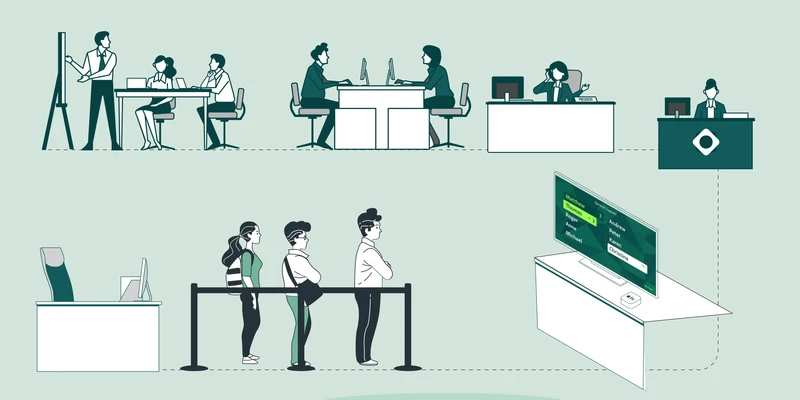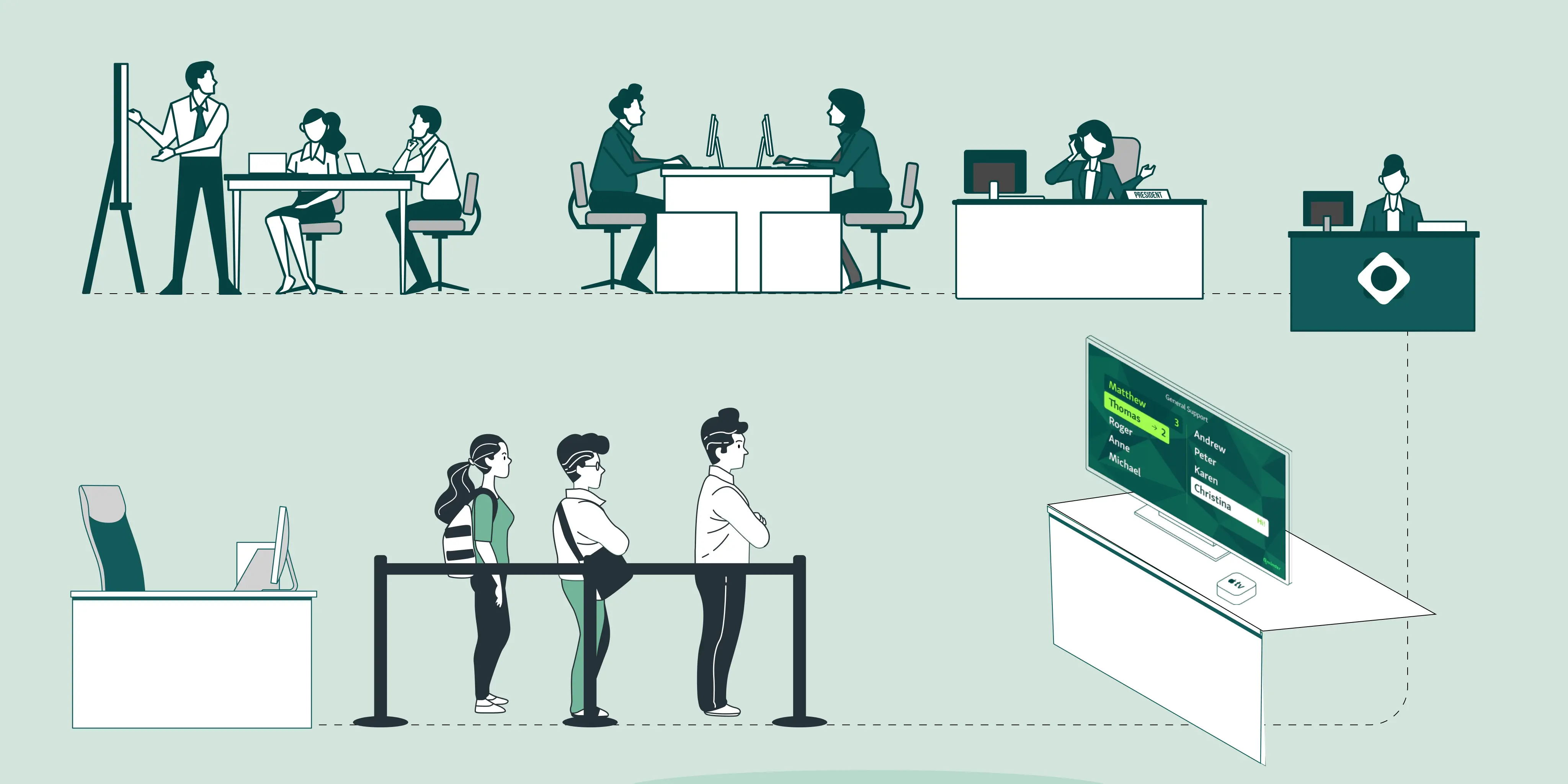Long lines, clipboards, and confusing sign-in sheets—paper-based queue systems still slow down many government offices, leading to inefficiency and citizen frustration.
People expect better. In fact, interest in digital interactions with the government has grown significantly: 38% of Canadians now want more digital interactions, up from 24% in 2019.
While in-person options still matter, especially for complex services, there's a clear demand for smarter, more efficient systems. A paperless queue system isn’t just about eliminating clutter, it’s about improving speed, transparency, and overall experience for both citizens and staff.
Let’s look at how switching to a paperless queue system boosts efficiency, cuts costs, improves communication, and supports sustainability in government services. For a broader overview of virtual queue benefits, see how these systems transform service delivery across industries.
The Pitfalls of Paper-Based Queuing
While familiar and easy to implement, paper-based queuing systems create more issues than they solve, especially in high-traffic government settings. Here’s a closer look at the main challenges:
1. Manual Errors and Inefficiencies
Relying on handwritten logs opens the door to frequent mistakes, incorrect spellings, hard-to-read entries, or misfiled sign-ins. These small errors can snowball into major service delays, especially when staff need to backtrack to verify information. Staff also waste valuable time sorting paperwork instead of assisting citizens, which reduces service capacity and slows down queues across departments.
2. Lack of Real-Time Visibility
With paper queues, there’s no centralized view of who's waiting, how long they've been waiting, or what services they’re here for. This blind spot makes it difficult for managers to allocate staff effectively or identify peak traffic periods. Without access to live queue data, offices miss opportunities to rebalance workloads or step in when delays build up.
3. Frustrating Experiences for Citizens
Paper-based sign-ins offer no confirmation, no status updates, and no transparency into how long the wait might be. Visitors are left in uncertainty, often checking in multiple times or asking staff for updates. This lack of communication erodes trust, causes anxiety, and contributes to a poor perception of government responsiveness.
How Much Does It Cost to Go Paperless?
The cost of switching to a paperless queue system depends on your department’s size, service volume, and implementation scope. Most government offices can expect to pay:
Software subscription: $100 to $500 per month per location, depending on features like appointment scheduling, real-time dashboards, and multilingual support.
Hardware: Tablets or kiosks typically range from $300 to $1,500 each, depending on brand and setup needs.
Staff training: Often included in the onboarding fee, but standalone training sessions may cost $500–$1,000.
Though there are upfront costs, governments usually recoup this through savings on paper, printing, filing, and admin hours—often within the first 6 to 12 months. Over time, better queue management also leads to improved citizen satisfaction and fewer service complaints.
You might also like - Queue Management Systems: Cost vs. Benefits Analysis for Public Sector Agencies
Key Benefits of Going Paperless
Let’s look at how switching to a paperless queue system boosts efficiency, cuts costs, improves communication, and supports sustainability in government services.
1. Real-Time Queue Visibility
Going paperless gives staff a live view of visitor flow,who's waiting, how long they’ve been waiting, and what service they need. This allows for smarter staffing decisions and quicker service adjustments during peak periods. Managers can easily identify bottlenecks and redistribute staff where they’re needed most.
Live dashboards help staff monitor queues and service times as they happen.
Queue data enables real-time decision-making and smoother visitor handoffs.
Better resource planning becomes possible with insights into peak traffic trends.
With Qminder, government offices gain access to a cloud-based dashboard and Waitlist TV that display real-time queue activity. Staff can track each visitor’s status, service need, and wait time from a single screen, while citizens stay informed through the display. This makes queue management faster, smarter, and more transparent.

2. Reduced Administrative Burden
Paper-based systems require staff to manually record, organize, and retrieve visitor information—tasks that are both time-consuming and error-prone. A digital queuing solution removes the need for handwritten logs and reduces time spent on repetitive tasks like sorting paperwork or re-entering data into other systems.
Automated data capture ensures cleaner, more accurate records.
Digital logs eliminate the need for manual filing and storage.
More staff time is freed up for citizen-facing service instead of admin work.
With an appointment queue software, visitor data is collected at check-in and stored automatically. Staff can view and update this information in real time without needing to juggle clipboards or file folders, optimizing back-office operations significantly.
3. Enhanced Communication
One of the biggest frustrations in traditional queuing is the lack of updates. With a paper-based system, citizens often have no idea where they stand in line or how long they’ll have to wait. Going paperless introduces real-time communication that keeps people informed and reduces uncertainty.
SMS or email notifications update visitors on their queue status.
Two-way messaging lets staff communicate changes or instructions directly.
Less crowding and confusion as people no longer need to linger or ask for updates.
Qminder makes communication seamless with built-in alerts features. Staff can send automated wait time alerts or manually message a visitor when their turn is approaching, ensuring clarity, reducing walkaways, and improving the overall service experience.

Helpful read - How to Improve Customer Communication With SMS Text Messaging
4. Data-Driven Decisions
Switching to a paperless queue system unlocks a wealth of data that helps government offices gain a clear understanding of visitor flow and service efficiency. Rather than relying on assumptions, managers can use real-time analytics to make smarter, evidence-based decisions that improve operations and reduce wait times.
Identify peak times and busy periods accurately to better allocate staff and resources when demand is highest.
Detect bottlenecks and service slowdowns in specific departments or processes, allowing targeted improvements to increase throughput.
Monitor individual staff performance and service times to provide focused training and optimize workforce productivity.
With an appointment scheduling software that includes a comprehensive analytics dashboard, decision-makers receive actionable insights that enable continuous process refinement. This leads to faster, more efficient operations and a smoother, citizen-friendly government service experience.

5. Greener, More Sustainable Operations
Moving to a paperless queue system helps government offices significantly reduce their environmental impact by cutting down on paper usage and waste. This shift supports broader sustainability goals and reflects a commitment to eco-friendly practices that citizens increasingly value.
Eliminate piles of printed tickets, sign-in sheets, and forms that often end up as waste.
Reduce the carbon footprint associated with printing and paper disposal, contributing to a healthier environment.
Support government sustainability initiatives by adopting modern, digital solutions that conserve resources.
Paperless queuing systems like Qminder not only improves operational efficiency but also helps government departments demonstrate responsibility toward greener, more sustainable public service.
6. Automates Routine Tasks
Digital queue management systems automate many routine and repetitive tasks that otherwise consume staff time and slow down service. Automation ensures that follow-ups, notifications, and queue updates happen seamlessly without manual intervention. This reduces human error and helps prevent bottlenecks, enabling staff to focus on assisting citizens rather than administrative work.
Automatically notify staff and citizens when their turn approaches or when specific process steps are completed, improving transparency.
Set customizable reminders and alerts for staff to ensure no step or customer is overlooked, keeping the queue moving efficiently.
Optimize workflows by eliminating paper forms and manual data entry, reducing delays caused by misplaced paperwork.
An appointment scheduling software with automation features enhances operational flow and citizen communication, resulting in faster, smoother service experiences. Its intuitive dashboard lets staff customize notifications and monitor tasks with ease, adapting to each department’s unique requirements.
7. Enhances Data Accessibility Across Departments
Paperless queue systems leverage cloud technology to make queue data and visitor information instantly accessible to authorized personnel across multiple government departments. This real-time access improves collaboration, as all teams can view and update the same information without delays or version conflicts.
Staff can securely access, update, and manage queue data anytime, anywhere, using mobile devices or desktops.
Centralized storage ensures all departments work from consistent, up-to-date information, reducing errors and miscommunication.
Improved cross-department collaboration speeds up issue resolution and delivers a more seamless citizen experience.
Qminder’s cloud-based platform supports efficient, transparent communication between departments, enhancing overall government service delivery. The system’s role-based permissions guarantee that sensitive data remains protected while enabling seamless access for authorized users.
8. Improves Security and Disaster Recovery
Paper documents are highly vulnerable to physical damage such as fire, water, or loss, which can jeopardize critical records and disrupt government operations. Switching to a paperless queuing system significantly enhances data security by storing information in encrypted, cloud-based environments with regular backups. This ensures data integrity and availability, even in emergencies.
Protect vital queue and visitor data from environmental hazards or accidental loss with secure digital storage.
Benefit from automated backups and rapid data recovery options that minimize downtime during disasters or technical failures.
Ensure compliance with data protection regulations through encrypted storage and controlled access protocols.
Qminder ensures your queue management is not only efficient but also secure, complying with GDPR, HIPAA, and SOC 2 Type II standards. This means your customer data is protected with industry-leading safeguards, giving you peace of mind while improving service delivery.
Also read - 9 Proven Benefits of Online Queue Management Systems
Case Study: How the City of Greensboro Benefited from Paperless Queuing
The City of Greensboro, North Carolina, faced significant challenges managing walk-in visitors. Their traditional paper-based system led to long wait times, overcrowded lobbies, and inefficiencies in staff allocation. The onset of the COVID-19 pandemic further highlighted the need for a more streamlined and contactless solution.
Implementation of Qminder
To address these issues, Greensboro adopted Qminder’s digital queue management system. This transition allowed for:
Remote Sign-In: Visitors could check in via tablet kiosks or receive SMS links to sign in before arriving.
Real-Time Communication: Staff could send updates and alerts to visitors, reducing uncertainty.
Data Collection: The system captured essential visitor information, enabling better service preparation.
Measurable Outcomes
Post-implementation, Greensboro observed:
Significant Reduction in Wait Times: Average wait times decreased to near zero, enhancing citizen satisfaction.
Improved Staff Efficiency: Automated processes freed up staff to focus on service delivery rather than administrative tasks.
Enhanced Citizen Experience: The streamlined process led to a smoother, more predictable service experience for visitors.
With a paperless queue system, Greensboro not only improved operational efficiency but also demonstrated a commitment to modernizing public services in response to evolving citizen expectations.
Addressing Concerns About Going Digital
Going paperless brings clear advantages, but it's normal for city departments to have concerns—especially around accessibility, data security, and costs. Here's how a well-designed system addresses each of these.
-
Accessibility for Older or Offline Citizens
Not every citizen is comfortable with digital systems—but paperless doesn’t have to mean self-service only. Solutions like Qminder support hybrid options, including staff-assisted check-ins or easy-to-use kiosks, ensuring accessibility for people of all ages and tech abilities. Staff can guide visitors through the process, offering help without slowing things down.
-
Privacy and Security of Citizen Data
Digital queue systems like Qminder are built with data protection in mind, complying with standards like GDPR and HIPAA where applicable. Encryption, controlled access, and secure data storage ensure sensitive citizen information is handled responsibly and transparently.
-
Cost of Implementation
Upfront tech investment can be a concern, but paperless queueing often pays for itself over time. Reducing paper, minimizing manual labor, and streamlining workflows leads to long-term savings. Many cities also reduce lobby crowding and improve staff efficiency—maximizing the return on investment.
Read more - Queue Management Systems: Cost vs. Benefits Analysis for Public Sector Agencies
It’s Time to Ditch the Clipboard
Outdated, paper-based queues hold government offices back—wasting time, increasing frustration, and limiting transparency. Moving to a paperless system isn’t just a tech upgrade; it’s a step toward better service, greater efficiency, and more trust from the public.
Even a small pilot program can highlight the impact of digital queue management. With real-time insights, reduced admin work, and improved citizen communication, the benefits are clear.
Qminder makes this transition simple. Its intuitive, cloud-based queue system helps your department serve smarter, with less stress and more impact.
Ready to get started? Explore how Qminder can support your digital transformation.
Most paperless queue systems, like Qminder, offer API access and integrations with common government platforms such as CRMs or case management tools. This ensures seamless data flow, reduces manual entry, and maintains consistency across systems. Setup can be customized based on your department’s specific workflows and software stack.
Training is typically minimal. Qminder, for example, is designed with a user-friendly interface that staff can pick up in under an hour. Most providers offer onboarding sessions, support documentation, and ongoing help to ensure staff feel confident and supported.
Modern queue systems follow strict security standards such as GDPR, HIPAA, and SOC 2 compliance. Data is encrypted in transit and at rest, with role-based access controls and audit logs to ensure accountability. Qminder prioritizes data protection to safeguard citizen information at every touchpoint.




